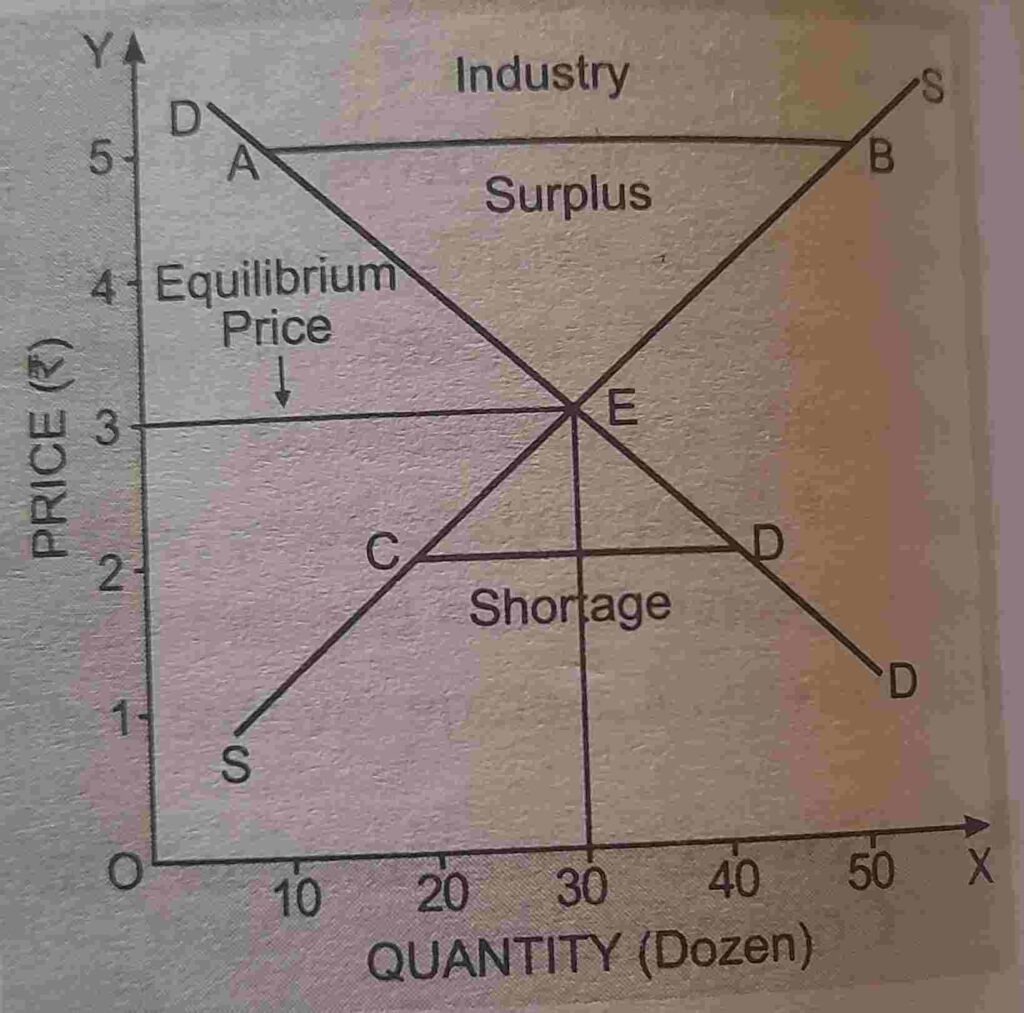
What is a perfect Competition? What are its Characteristics? How is the price of a commodity determined under perfect Competition? ( 2016 )
Perfect Competition:- Perfect Competition is that market where there are a large number of buyers and sellers of homogeneous products. It is impossible to distinguish between the units being sold by them. So the price of the commodity is determined by the industry. At the same determined price all firms will sell their products.
According to Ferguson:- “Perfect Competition describes a market in which there is Complete absence of direct Competition among economic firms.
Characteristics of Perfect Competition
Main Characteristics of perfect Competition are as Under.
- Large Number of buyers and Sellers:- One seller can’t influence the price of a product.
- Homogeneous Products:- All sellers sell homogeneous products.
- Perfect Knowledge:- Buyer and Sellers are fully aware of the price of the products.
- Free Entry and Exit of Firms:- Under perfect competition, Any new firm can enter into industry at any time and old firms can exit at any time.
- Perfect Mobility:- Any firm can sell their products at any place without interference of any firms and government.
- Lack of Transport Costs:- Cost of transport can’t influence the price of products. All sellers had to sell their products at the same price as what prevailed in the markets regardless of the costs of transport.
- Same Price:- Each seller charges the same price from the buyer for the same products.
Price Determination Under Perfect Market Competition:-
Price under perfect competition is determined by the industry, not by any seller or firm. Collection of All firms available in the market is Called Industry.
So the price under the perfect Competition market is determined at that point where equilibrium is established between Demand and Supply.
In other words:- Where Demand is equal to the Supply by the Industry in market.
However, We will understand this logic with the help of the following table.
| Price Per Unit ₹ | Supply of Good-x( In Dozens ) | Demand for Good-X( in Dozens ) |
| 5 4 3 2 1 | 50 40 30 20 10 | 10 20 30 40 50 |
Table Shows that When price of good-X is ₹5 per Dozen, its Supply is of 50 Dozens and Demand is for 10 Dozens.
- Here Supply is more than demand. Due to which there will be competition among the Sellers of good X. As a result , the price of good-X will Fall.
- Fall in price will decrease supply but extend demand.
- When price falls to ₹3 per dozen, then demand becomes equal to supply.
- Thus, ₹3 per dozen is the Equilibrium price of good-X.
- If prices fall more than ₹2 then demand will be more than supply.
- Again it will lead to competition among buyers. As a result , once again the price will begin to rise till it reaches ₹3 per dozen.
- At this point an equilibrium will be established and price will be set by the forces of Demand and Supply.
Now we can consider it deeply with the following Figure.

- Units of good-X are Shown on X-axis and Price on Y- axis. DD is the demand Curve. And It slopes downward from left to right.
- SS is the Supply Curve of Industry. And It slopes upwards from left to right.
- Now we see in figure that Supply and Demand Curve intersect each other at point E.
- At ₹3 Supply and Demand will be equilibrium at point E.
- If the price rises to ₹5, then supply will become 50 dozens which is more than the demand.
- It is cleared from the figure at ₹5 the excess supply is equal to AB.
- In this situation supply being more than demand, there will be a situation for the price to fall and it will revert back to equilibrium price of ₹3.
- In case the price falls to ₹2, then supply of 20 dozen will be less than demand for 40 dozen.
- Demand being more than supply, there will be a tendency for the price to rise.
- CD represents shortage in figure. This shortage or excess demand will push the price back to equilibrium level₹3.
Conclusion:- Price of good-x is determined by the industry at the point where demand is equal to supply. Price of the goods under perfect competition is determined by the industry and each firm has to sell its product at this very price.
Essential Questions of Economics
- Discuss the Nature and Scope of Micro Economics. ( 2016 )
- What is the cardinal utility analysis? Critical Examine the law of diminishing Marginal Utility. ( 2016 )
- What is the cardinal utility analysis? Discuss equilibrium of the consumer through utility analysis. (2017)
- Explain the Revealed Preference Hypothesis. How can you derive the law of demand through Revealed Preference Theory? ( 2016 )
When you tired on the way of study you can read stunning poetry as per your interest from the given category.